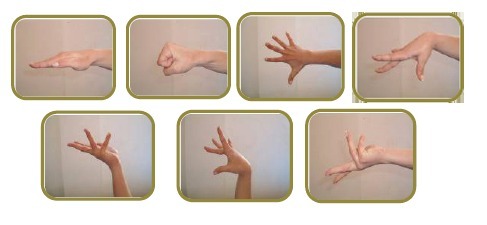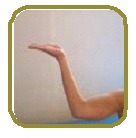In the Aerobic Content, we evaluate the Aerobic Movement Patterns (AMP) throughout the routine. The series of AMP are the foundation (bases) of Aerobic Gymnastics routines.
The quality (perfect technique) of the AMP is very important in order to be recognizable as a complex AMP sequence.
AMP must include variations of steps with arm movements, utilizing basic steps to produce complex combinations with a high level of body coordination and must be recognizable as continuous movement patterns.
AMP Sequence means a complete 8-count of movements with aerobic movement patterns performed in a musical phrase (from the 1st beat to the 8th beat) in order to stay with the music. If the AMP is performed for less than 8 counts, it will not be recognized as an AMP sequence, and considered as linking movements.
The AMP sequences should provide the adequate intensity for the aerobic gymnastics routines.
CRITERIA:
2.1 Complexity / Variety
2.2 Creativity
2.3 Intensity
The quality (perfect technique) of the AMP is very important in order to be recognizable as a complex AMP sequence.
AMP must include variations of steps with arm movements, utilizing basic steps to produce complex combinations with a high level of body coordination and must be recognizable as continuous movement patterns.
AMP Sequence means a complete 8-count of movements with aerobic movement patterns performed in a musical phrase (from the 1st beat to the 8th beat) in order to stay with the music. If the AMP is performed for less than 8 counts, it will not be recognized as an AMP sequence, and considered as linking movements.
The AMP sequences should provide the adequate intensity for the aerobic gymnastics routines.
CRITERIA:
2.1 Complexity / Variety
2.2 Creativity
2.3 Intensity
2.1. Complexity / Variety
AMP is the base of the aerobic gymnastics and main (principal) characteristic (Sports Specific). Therefore the complexity and variety of the AMP sequences are the most important criteria under the Aerobic Content.
The AMP Sequences are complex when both, legs and arms, are combined together with a high level of body coordination.
The specific technique of the basic steps is described in the Appendix II. The leg movements must show the correct technique of Aerobic Basic Steps, including the variations.
The arm movements for aerobic gymnastics has specific technique, therefore the gymnasts must perform them with quality. The arm movements must show precision and fluency, with a clear trajectory from one position to another, showing the capacity to accelerate and decelerate the arm movement, with appropriate carriage of the head, the shoulders and the upper body.
Complex AMP sequences can be achieved by:
Throughout the routine, AMP Sequences must show variety without repetition of the same step/arm movements in the same 8 counts and the same or similar type of AMP Sequences during the routine. All basic steps must be used throughout the routine.
In order to achieve variety inside the AMP sequence, it is highly recommended to show in every 8 counts of AMP at least 3 different basics steps, without no more than 2 repetitions of the same basic step in the same 8 counts.
By showing variety of movements during the performing of every 8 counts of AMP, will also increase the level of complexity.
Examples of variations of 7 basic steps (also see execution descriptions in Appendix II).
The AMP Sequences are complex when both, legs and arms, are combined together with a high level of body coordination.
The specific technique of the basic steps is described in the Appendix II. The leg movements must show the correct technique of Aerobic Basic Steps, including the variations.
The arm movements for aerobic gymnastics has specific technique, therefore the gymnasts must perform them with quality. The arm movements must show precision and fluency, with a clear trajectory from one position to another, showing the capacity to accelerate and decelerate the arm movement, with appropriate carriage of the head, the shoulders and the upper body.
Complex AMP sequences can be achieved by:
- Involving more body parts (head, shoulders, etc…)
- Using different joint actions / planes / range of motion / lever length
- Using asymmetric moves
- Using different rhythm
- Increasing the frequency of movement, by using both arms simultaneously and the speed of motion.
- Orientation changing
- Formation changing (for MP/TR/GR)
- Travelling with AMP sequences
Throughout the routine, AMP Sequences must show variety without repetition of the same step/arm movements in the same 8 counts and the same or similar type of AMP Sequences during the routine. All basic steps must be used throughout the routine.
In order to achieve variety inside the AMP sequence, it is highly recommended to show in every 8 counts of AMP at least 3 different basics steps, without no more than 2 repetitions of the same basic step in the same 8 counts.
By showing variety of movements during the performing of every 8 counts of AMP, will also increase the level of complexity.
Examples of variations of 7 basic steps (also see execution descriptions in Appendix II).
- March: angle, height, speed, rhythm change, or directions. (i.e. V-step, turn-step, two-steps, box-step)
- Jog: angle, speed, rhythm change, and directions
- Knee lift: planes, angle, speed, rhythm change, in High or Low Impact
- Kick: planes, height, speed, rhythm change, in High or Low Impact and directions. (i.e. middle kick, high kick, and vertical kick)
- Jumping Jack: angle at hips and knees speed, rhythm change, in High or Low Impact (squat)
- Lunge: planes, angle, speed, rhythm change, in High or Low Impact
- Skip: planes, angle and directions, speed, rhythm change, in High or Low Impact.

INADEQUATE FINGER ACTIONS (NOT TO BE ABUSED)

2.2. Creativity

The AMP sequences must be used to enhance the performance and respecting the nature of the aerobic gymnastics discipline.
The AMP sequences must have high correlations with the theme and the style of the music. There must be a reason why to include that arm(s) movement, without losing the style of the choreography. The use of the head and the torso during the execution of the AMP may be another possibility to include in the choreography.
The high level of creativity in the AMP sequences must be shown by using the seven basic steps and arm movements to the music style and accents, without repetitions and in sport manner, respecting the gender of the competitor(s).
Feminine arm and upper body movements and masculine arm and body movements must be distinctive, especially with the use of different actions of the hands and wrist (hyper flexion or the wrist), unless it has especial meaning for the style of the choreography but without “abuse” (example Egyptian Music)
When men and women are together in the same team (MP, TR, GR), it is recommended to use neutral movements, however it will be possible to make different movements on purpose in the choreography for the men and the women in some parts of the routine without loosing the synchronisation mistake.
AMP movements should be precise, elegant, neat, smooth and graceful, and following the music (rhythm, melody, etc.).
The AMP sequences must have high correlations with the theme and the style of the music. There must be a reason why to include that arm(s) movement, without losing the style of the choreography. The use of the head and the torso during the execution of the AMP may be another possibility to include in the choreography.
The high level of creativity in the AMP sequences must be shown by using the seven basic steps and arm movements to the music style and accents, without repetitions and in sport manner, respecting the gender of the competitor(s).
Feminine arm and upper body movements and masculine arm and body movements must be distinctive, especially with the use of different actions of the hands and wrist (hyper flexion or the wrist), unless it has especial meaning for the style of the choreography but without “abuse” (example Egyptian Music)
AMP movements should be precise, elegant, neat, smooth and graceful, and following the music (rhythm, melody, etc.).
2.3. Intensity
According the definition of the COP, aerobic gymnastics is the ability to perform continuous complex and high intensity aerobic movement patterns to music. Therefore the AMP sequences must provide the adequate power.
Intensity is a measure of the energy and dynamism of the routine. Majority of the routine’s intensity depends on AMP movements. Therefore, AMP sequences must be performed without any unnecessary pauses and with fluency and precision of every single movement, showing the capacity to maintain the intensity level from the beginning to the end.
The intensity must be shown by using the AMP sequences with complexity, creativity and variety and not by jogging around to cover the competition space.
Arm movements can be in different ranges of motion some of them can be more “delicate” as far as they have a meaning with the idea of the choreography, with the style and the category of the competitor.
Rebounding is clearly a critical component in the aerobic program, however real jumping skills should be encouraged as well. These bring ‘breathe’ and ‘awe’ to a performance. Jumps are more ‘suspended’ in the air and are equally ‘aerobic’ if well executed.
Intensity is a measure of the energy and dynamism of the routine. Majority of the routine’s intensity depends on AMP movements. Therefore, AMP sequences must be performed without any unnecessary pauses and with fluency and precision of every single movement, showing the capacity to maintain the intensity level from the beginning to the end.
The intensity must be shown by using the AMP sequences with complexity, creativity and variety and not by jogging around to cover the competition space.
Arm movements can be in different ranges of motion some of them can be more “delicate” as far as they have a meaning with the idea of the choreography, with the style and the category of the competitor.
Rebounding is clearly a critical component in the aerobic program, however real jumping skills should be encouraged as well. These bring ‘breathe’ and ‘awe’ to a performance. Jumps are more ‘suspended’ in the air and are equally ‘aerobic’ if well executed.
SUMMARY2.1. Complexity / Variety:
DEVIATION FROM EXCELENT (examples)
2.2. Creativity:
DEVIATION FROM EXCELENT (examples)
2.3. Intensity:
DEVIATION FROM EXCELENT (examples)
- Use of the coordination criteria
- Perfect technique (quality)
- Use of the variety criteria
DEVIATION FROM EXCELENT (examples)
- Predominating of the jog / march / chasse in the whole routine, and or missing basics steps
- Lack of frequency of the arm movements (i.e. arm movements performed in double time)
- Arm movements are complex but the step combinations are simple or vice versa
- There is not precision/clear shape in the arm movements
- Lack of different arms actions
- Repetitive arm/leg movements
- Too many super high impact movements
2.2. Creativity:
- AMP sequences enhance the routine
- Correlation between the AMP sequences and the style of the music and the routine
- Use of imagination in sport manner
DEVIATION FROM EXCELENT (examples)
- Feminine movements used by men or masculine movements performed by women
- Abuse of inadequate hand/fingers
- AMP movements are not precise, elegant, neat, smooth and/or graceful.
- Abuse to theatrical movements not respecting the sport manner.
2.3. Intensity:
- Intensity maintained throughout the routine using the previous criteria with the AMP sequences
- Rebounding
- Dynamic routines
DEVIATION FROM EXCELENT (examples)
- Lack or diminish of intensity with the AMP
- Not enough speed/frequency of movements
- Excessive use of jogging actions
- Excessive use of super high impact movements





